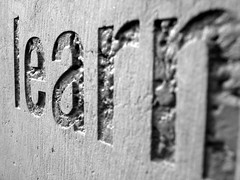My model of a good XXX [is] multiple gateways to engagement.
A year ago I was asked to be on a leadership training committee at my synagogue. At these monthly meetings I learn about the synagogue and it's role in Jewish Los Angeles and the Reform Movement as a whole. In June, our group was asked to read Sacred Strategies: Transforming Synagogues from Functional to Visionary, and one of the authors, Isa Aron, came to speak with us. I haven't stopped thinking of the parallels between the 21st century journeys of two institutions, the library and the Reform Jewish synagogue. I wonder how comparing the issues and solutions might help us both. I wonder if other institutions, religious or otherwise, have similar challenges.
Challenges:
Library (especially public): How do we keep families involved after the toddlers grow up?
Synagogue: How do we keep families involved after preschool?
Library: If students are reading more online, getting their information online, how do we keep the teenagers involved in the life of the Library?
Synagogue: If students can now do their Bar Mitzvah preparation via Skype, how do we keep the teenagers involved in Temple life?
Library: Many exciting activities are competing for the time and interests of students today. How do we make our resources available, relevant, and essential?
Synagogue: Many exciting activities are competing for the time and interests of students today. How do we make our resources available, relevant, and essential?
Library: How can we promote lifelong learning through the library?
Synagoge: How can we promote lifelong learning through the Synagogue?
How do we promote the importance of the sense of community found in both institutions? How can our institutions learn from each other? How do we blend and balance the virtual and the physical?
We learn so much from going outside of our profession to gain insights from others which we can adapt for libraries (remember Good to Great?). Our school library leaders, like Buffy Hamilton, adapt foundational ideas from marketers and innovators like Seth Godin and Guy Kawasaki, and transform these ideas for libraries. Hamilton's Pivot Points for Change (inspired by Seth Godin's post Pivot's for Change), and Participatory Librarianship: Creating Enchantment and Conversations for Learning (inspired by Guy Kawasaki's book, Enchantment: The Art of Changing Hearts, Minds, and Actions) could both be adapted to inspire synagogue leaders. Professionals at both institutions talk a lot about participation, collaboration, creating community, branding, access points, being where the users are, creating experiences. What can we learn from the Jewish Reform Movement?
I am much less knowledgeable about the conversations and discussions of the Jewish leaders on these issues. But here is what I have found by reading Sacred Strategies:
The synagogues and libraries are using the same lingo!
The authors differentiate between functional and visionary congregations. Functional ones are "those that may excel at performing discrete functions...but tend to fall short of genuinely achieving an integrated sense of sacred community," (Aron 15) and they are characterized by:
- Consumerist purpose
- Segmentation in programming
- Passivity
- Meaninglessness ("failure to excite, provoke, mobilize, or inspire congregants")
- Resistance to change
- Nonreflective leadership
- Sacred purpose: a pervasive and shared vision infuses all aspects of the synagogue
- Holistic ethos: the parts are related to each other, such that the whole is greater than the sum of its parts
- Participatory culture on all levels: congregants, lay leaders, professionals, and family members of all ages engage in the work of creating sacred community
- Meaningful engagement achieved through inspirational experiences
- Innovation disposition marked by a search for diversity and alternatives and a high tolerance for possible failure
- Reflective leadership and governance
What would you add?
P.S.
The quote at the top of this post is from: Sacred Strategies, pg 4.


What an interesting comparison you have made! The list of characteristics of visionary congregations really does work as a guide for making our libraries more visionary. Thanks for sharing these thoughts.
ReplyDeleteI enjoyed reading this blog and find your visionary thoughts really interesting! It may well be worth pursuing - NOW!!! to put it to practice?
ReplyDelete